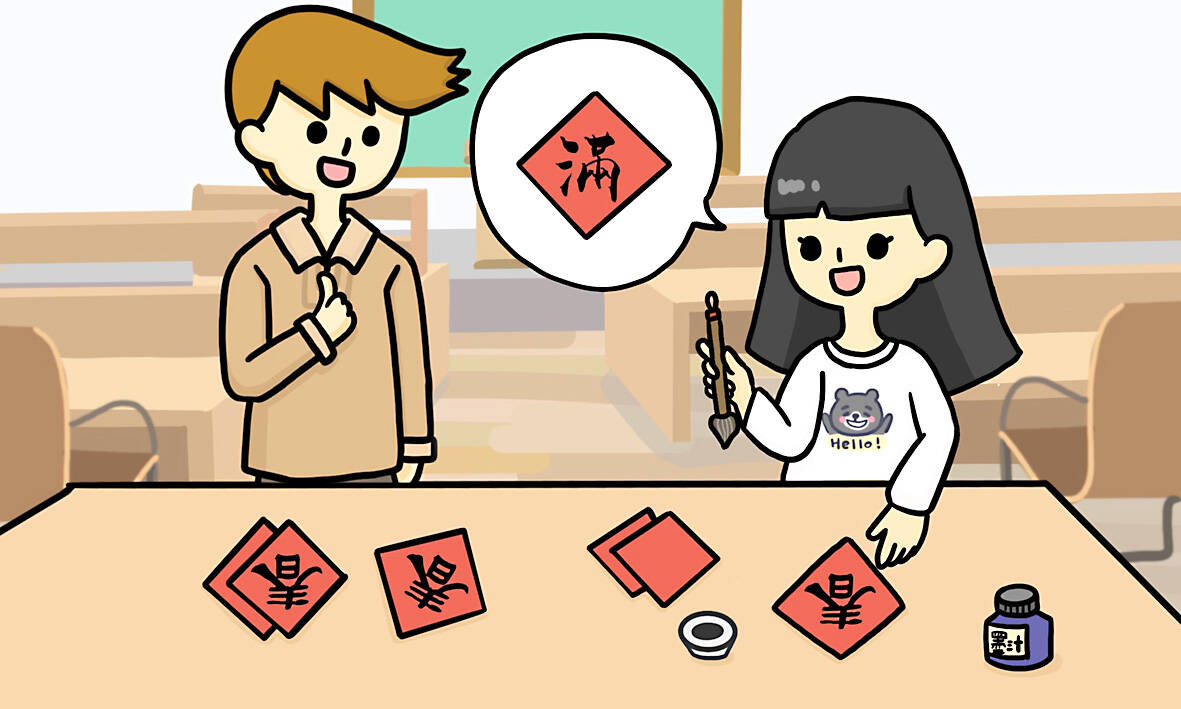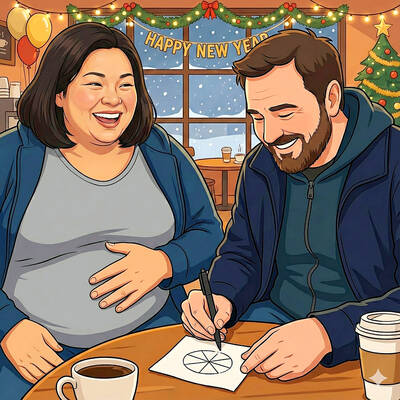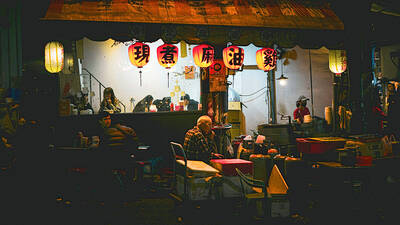對話 Dialogue
馬克:小實,你用毛筆在寫什麼啊?
Mǎkè: Xiǎoshí, nǐ yòng máobǐ zài xiě shénme a?

小實:我在寫「春」字啊!
Xiǎoshí: Wǒ zài xiě chūn zì a!
馬克:看起來很有趣耶,你在準備農曆新年嗎?
Mǎkè: Kàn qǐlái hěn yǒuqù yé, nǐ zài zhǔnbèi nónglì xīnnián ma?
小實:對啊,這是我要貼在家裡祈求好運的。
Xiǎoshí: Duì a, zhè shì wǒ yào tiē zài jiālǐ qíqiú hǎoyùn de.
馬克:你用紅紙代表喜慶,「春」字是代表春天要來了嗎?
Mǎkè: Nǐ yòng hóngzhǐ dàibiǎo xǐqìng,`chūn' zì shì dàibiǎo chūntiān yào lái le ma?
小實:沒錯,除了「春」以外,「福」也是過年常用的字喔!
Xiǎoshí: Méicuò, chúle `chūn' yǐwài,`fú' yěshì guònián chángyòng de zì ō!
馬克:「福氣」的「福」嗎?我猜應該是希望新的一年很好運。
Mǎkè: `Fúqi' de `fú' ma? Wǒ cāi yīnggāi shì xīwàng xīn de yì nián hěn hǎoyùn.
小實:沒錯!還有「滿」字也常貼在冰箱外,祈求新年食物足夠。
Xiǎoshí: Méicuò! Hái yǒu `mǎn' zì yě cháng tiē zài bīngxiāng wài, qíqiú xīnnián shíwù zúgòu.
馬克:這實在太有趣了,我也想要學寫這些字!
Mǎkè: Zhè shízài tài yǒuqù le, wǒ yě xiǎng yào xué xiě zhèxiē zì!
翻譯 Translation
Mark: Xiaoshi, what are you writing with that Chinese brush?
Xiaoshi: I am writing the character chun [spring].
Mark: That looks interesting. Are you preparing for Lunar New Year?
Xiaomi: Yes, I will put this up at home as a prayer for good luck.
Mark: You used red paper to represent joy. Does the word chun mean that spring is coming?
Xiaomi: Yes, in addition to chun, fu [bliss] is another commonly used word during Lunar New Year.
Mark: Is “blessing” the same as fu? I guess you wish good luck in the new year.
Xiaoshi: That’s right! And the character man [full] is often stuck on the refrigerator to pray for enough food in the New Year.
Mark: This is so interesting. I want to learn to write these words, too!
單字片語 Vocabulary
1. 農曆 (Nónglì) lunar calendar
2. 祈求 (qíqiú) to pray
3. 好運 (hǎoyùn) good luck
4. 代表 (dàibiǎo) to represent
5. 喜慶 (xǐqìng) joy, festive
6. 福氣 (fúqi) blessing
7. 足夠 (zúgòu) enough
8. 實在 (shízài) really
教材音檔 Audio Files
教材影片 Video Files:
https://www.instagram.com/celc.nou_tw/guide/_/17999106352646292/
實踐大學華語中心提供
By Shih Chien University Chinese Language Center: https://chineseusc.com/

★ Bilingual Story is a fictionalized account. 雙語故事部分內容純屬虛構。 “Any New Year’s resolutions?” he asked. Lena put her coffee down. “Yeah,” she said. “To get in shape.... round is a shape, right?” Mark chuckled. “I support this. Fully achievable. Low risk.” “Thanks,” she smiled and lovingly rubbed her round belly. “I like a resolution I can’t fail.” “Funny thing is, I was thinking about getting round too.” Lena nodded her head in approval, “You could put some meat on those skinny bones of yours.” Mark shook his head, “Not that kind of round. Wheel-of-Life round.” She raised an eyebrow.

詞法—不定詞的誤用 1. 我得記住星期五要把報告寫好。 ˇ I must remember to finish my report by Friday. χ I must remember finishing my report by Friday. 註︰remember 後面跟動名詞或不定詞表示兩種不同的概念,與 forget 相類似。 試比較下列句子: I remember meeting him somewhere.(我記得曾經在某處見過他。) I must remember to meet him at the station at six this evening. (我必須記住今晚六點得去車站接他。) He remembered turning off the light when he left the room. (他記得離開房間時曾先把燈熄了。) Remember to turn off the light when you leave the room. (記住離開房間時要把燈關了。) 2. 他提醒她做好她份內的事。 ˇ He reminded her to do her job. χ He reminded her of doing her job. 註︰remind ... of ... 後面跟動名詞,表示「使人想起做過某事」。若是「提醒某人應做某事」,應用 remind ... to do ...。試比較下列句子: He reminded me of my attending the lecture last Friday. (他讓我想起我上星期五去聽過那次演講。) He

對話 Dialogue 清清:最近天氣越來越冷,感覺很容易感冒,要不要一起去吃薑母鴨或是羊肉爐? Qīngqing: Zuìjìn tiānqì yuèláiyuè lěng, gǎnjué hěn róngyì gǎnmào, yào bú yào yìqǐ qù chī jiāngmǔyā huòshì yángròulú? 華華:最近我覺得有點累,想吃薑母鴨,可是又怕一下子吃太補會上火。 Huáhua: Zuìjìn wǒ juéde yǒudiǎn lèi, xiǎng chī jiāngmǔyā, kěshì yòu pà yíxiàzi chī tài bǔ huì shànghuǒ. 清清:那我們去喝香菇雞湯吧,不太容易上火,喝了也會很暖和。 Qīngqing: Nà wǒmen qù hē xiānggū jītāng ba, bú tài róngyì shànghuǒ, hē le yě huì hěn nuǎnhuo. 華華:聽起來不錯!你們家平常冬天都吃什麼進補? Huáhua: Tīng qǐlái búcuò! Nǐmen jiā píngcháng dōngtiān dōu chī shénme jìnbǔ? 清清:我家都煮麻油雞,吃完整個人手腳都會熱起來。我也很久沒喝香菇雞湯了,正好可以去打打牙祭。 Qīngqing: Wǒ jiā dōu zhǔ máyóujī, chī wán zhěnggè rén shǒujiǎo dōu huì rè qǐlái. Wǒ yě hěn jiǔ méi hē xiānggū jītāng le, zhènghǎo kěyǐ qù dǎ dǎ yájì. 華華:可是我最近在減肥,會不會吃得太補,肉又長回來了? Huáhua: Kěshì wǒ zuìjìn zài jiǎnféi, huì bú

A: Apart from Taiwan’s A-mei, Mayday and Jolin Tsai, there are many foreign singers coming to Taiwan early this year. B: The South Korean girl group Babymonster are playing two shows at Taipei Arena starting from tonight. Who else is coming to Taiwan? A: Other artists include Australian band Air Supply, K-pop superstar Rain, boy group Super Junior, TXT, US singers Giveon and Josh Groban, and Irish boy group Westlife. B: Air Supply was the first foreign band to come to Taiwan in 1983, and they’re probably the most frequently visiting group too. A: As the year is beginning